Bidirectional Associations between Parental Non-Responsive Feeding Practices and Child Eating Behaviors: A Systematic Review and Meta-Analysis of Longitudinal Prospective Studies
Abstract
:1. Introduction
2. Materials and Methods
2.1. Design
2.2. Data Sources and Search Strategy
2.3. Inclusion and Exclusion Criteria
- (1)
- Both parental feeding practices and child eating behaviors were reported.
- (2)
- (1)
- Were reviews, editorials, commentaries, letters, or methodological papers;
- (2)
- Were non-English papers;
- (3)
- Did not report the bidirectional relationships between caregivers’ non-responsive feeding practices and children’s eating behaviors;
- (4)
- Focused on children with diseases that might influence their eating;
- (5)
- Included primary caregivers who were not the child’s parents;
- (6)
- Used observation for the assessment of feeding practices or eating behaviors. Observational assessment may be subject to the constraints of specific occasions and, thus, cannot represent the meaning of behavior completely, while self-reports tend to refer to general practices [39,40]. Additionally, self-reports of feeding showed greater stability over time than observational measures [41]. This large discrepancy between observed and self-reported information may result in methodological inconsistency across the studies.
2.4. Study Screening and Data Extraction
2.5. Primary and Secondary Outcomes
- (1)
- Restriction means that the caregivers enforce strict limitations on the child’s access to food or opportunities to consume specific food [45]. Typically, restrictive feeding practices are used to control child’s intake of unhealthy food [30,46,47,48]. Restriction for weight is another common restrictive feeding [46].
- (2)
- (3)
- (4)
- Use food as a reward, also called instrumental feeding, involves using threats and bribes or pushing children to eat more [45,50]. Based on the conceptual model proposed by Vaughn [45], using food as a reward was classified into reward for eating, reward for behavior, and nonfood-based incentives to eat.
- Nonfood incentives to eat means that threats and bribes around child eating behaviors (e.g., eating disliked food) may be nonfood incentives (e.g., stickers) [45].
- (1)
- (2)
- (3)
- Food responsiveness refers to the desire to eat food when they see or smell food or are supplied with food [54]. It is assessed behaviorally on the basis of the amount of good-tasting versus less-good-tasting food consumed in normal conditions [51]. The items of food responsiveness are on self-reported desire for food following exposure to attractive food cues [51,55].
- (4)
- (5)
2.6. Quality Appraisal
2.7. Data Analyses
3. Results
3.1. Search Results
3.2. Quality Appraisal
3.3. Characteristics of the Studies
3.4. Measurements for Parental Feeding Practices
3.5. Measurements for Child Eating Behaviors
3.6. Longitudinal Associations between Parental Non-Responsive Feeding Practices and Child Eating Behaviors
3.6.1. Longitudinal Effects of Parental Non-Responsive Feeding Practices on Child Eating Behaviors (F→E)
3.6.2. Longitudinal Effects of Child Eating Behaviors on Parental Non-Responsive Feeding Practices (E→F)
4. Discussion
4.1. Limitations and Strengths
4.2. Implications
5. Conclusions
Supplementary Materials
Author Contributions
Funding
Institutional Review Board Statement
Informed Consent Statement
Conflicts of Interest
References
- World Health Organization. Obesity and Overweight [EB/OL]. Available online: https://www.who.int/news-room/fact-sheets/detail/obesity-and-overweight (accessed on 9 June 2021).
- Pan, X.F.; Wang, L.; Pan, A. Epidemiology and determinants of obesity in China. Lancet Diabetes Endocrinol. 2021, 9, 373–392. [Google Scholar] [CrossRef]
- Körner, A.; Kratzsch, J.; Gausche, R.; Schaab, M.; Erbs, S.; Kiess, W. New predictors of the metabolic syndrome in children—Role of adipocytokines. Pediatr. Res. 2007, 61, 640–645. [Google Scholar] [CrossRef] [PubMed] [Green Version]
- Reilly, J.J. Obesity in childhood and adolescence: Evidence based clinical and public health perspectives. Postgrad. Med. J. 2006, 82, 429–437. [Google Scholar] [CrossRef] [PubMed] [Green Version]
- Gordon-Larsen, P.; Adair, L.S.; Nelson, M.C.; Popkin, B.M. Five-year obesity incidence in the transition period between adolescence and adulthood: The national longitudinal study of adolescent health. Am. J. Clin. Nutr. 2004, 80, 569–575. [Google Scholar] [CrossRef] [PubMed]
- Carnell, S.; Wardle, J. Associations between multiple measures of parental feeding and children’s adiposity in United Kingdom preschoolers. Obesity 2007, 15, 137–144. [Google Scholar] [CrossRef] [Green Version]
- Swinburn, B.A.; Sacks, G.; Hall, K.D.; McPherson, K.; Finegood, D.T.; Moodie, M.L.; Gortmaker, S.L. The global obesity pandemic: Shaped by global drivers and local environments. Lancet 2011, 378, 804–814. [Google Scholar] [CrossRef]
- West, F.; Sanders, M.R. The lifestyle behaviour checklist: A measure of weight-related problem behaviour in obese children. Int. J. Pediatr. Obes. 2009, 4, 266–273. [Google Scholar] [CrossRef]
- Ruzicka, E.B.; Darling, K.E.; Sato, A.F. Controlling child feeding practices and child weight: A systematic review and meta-analysis. Obes. Rev. 2021, 22, e13135. [Google Scholar] [CrossRef]
- Lin, Q.; Jiang, Y.; Wang, G.; Sun, W.; Dong, S.; Deng, Y.; Meng, M.; Zhu, Q.; Mei, H.; Zhou, Y.; et al. Combined effects of weight change trajectories and eating behaviors on childhood adiposity status: A birth cohort study. Appetite 2021, 162, 105174. [Google Scholar] [CrossRef]
- Boots, S.B.; Tiggemann, M.; Corsini, N. “That’s enough now!”: A prospective study of the effects of maternal control on children’s snack intake. Appetite 2018, 126, 1–7. [Google Scholar] [CrossRef]
- Ventura, A.K.; Birch, L.L. Does parenting affect children’s eating and weight status? Int. J. Behav. Nutr. Phys. Act. 2008, 5, 15. [Google Scholar] [CrossRef] [PubMed] [Green Version]
- Vaughn, A.E.; Tabak, R.G.; Bryant, M.J.; Ward, D.S. Measuring parent food practices: A systematic review of existing measures and examination of instruments. Int. J. Behav. Nutr. Phys. Act. 2013, 10, 61. [Google Scholar] [CrossRef] [PubMed] [Green Version]
- Jansen, E.; Williams, K.E.; Mallan, K.M.; Nicholson, J.M.; Daniels, L.A. Bidirectional associations between mothers’ feeding practices and child eating behaviours. Int. J. Behav. Nutr. Phys. Act. 2018, 15, 3. [Google Scholar] [CrossRef] [Green Version]
- Savage, J.S.; Rollins, B.Y.; Kugler, K.C.; Birch, L.L.; Marini, M.E. Development of a theory-based questionnaire to assess structure and control in parent feeding (SCPF). Int. J. Behav. Nutr. Phys. Act. 2017, 14, 9. [Google Scholar] [CrossRef] [PubMed] [Green Version]
- Shi, C.; Li, N.; Dong, J.; Wang, L.; Li, X.; Ji, C.; Wang, X.; Chi, X.; Guo, X.; Tong, M.; et al. Association between maternal nonresponsive feeding practice and child’s eating behavior and weight status: Children aged 1 to 6 years. Eur. J. Pediatr. 2017, 176, 1603–1612. [Google Scholar] [CrossRef] [PubMed]
- Dev, D.A.; McBride, B.A.; Fiese, B.H.; Jones, B.L.; Cho, H. Risk factors for overweight/obesity in preschool children: An ecological approach. Child Obes. 2013, 9, 399–408. [Google Scholar] [CrossRef] [Green Version]
- Faith, M.S.; Scanlon, K.S.; Birch, L.L.; Francis, L.A.; Sherry, B. Parent-child feeding strategies and their relationships to child eating and weight status. Obes. Res. 2004, 12, 1711–1722. [Google Scholar] [CrossRef]
- Boucheron, P.; Bhopal, S.; Verma, D.; Roy, R.; Kumar, D.; Divan, G.; Kirkwood, B. Observed feeding behaviours and effects on child weight and length at 12 months of age: Findings from the SPRING cluster-randomized controlled trial in rural India. PLoS ONE 2020, 15, e0237226. [Google Scholar] [CrossRef]
- Beckers, D.; Karssen, L.T.; Vink, J.M.; Burk, W.J.; Larsen, J.K. Food parenting practices and children’s weight outcomes: A systematic review of prospective studies. Appetite 2021, 158, 105010. [Google Scholar] [CrossRef]
- Golan, M.; Crow, S. Targeting parents exclusively in the treatment of childhood obesity: Long-term results. Obes. Res. 2004, 12, 357–361. [Google Scholar] [CrossRef]
- Moore, S.N.; Tapper, K.; Murphy, S. Feeding goals sought by mothers of 3–5-year-old children. Br. J. Health Psychol. 2010, 15, 185–196. [Google Scholar] [CrossRef] [PubMed]
- Couch, S.C.; Glanz, K.; Zhou, C.; Sallis, J.F.; Saelens, B.E. Home food environment in relation to children’s diet quality and weight status. J. Acad. Nutr. Diet. 2014, 114, 1569–1579.e1. [Google Scholar] [CrossRef] [PubMed] [Green Version]
- Yee, A.Z.; Lwin, M.O.; Ho, S.S. The influence of parental practices on child promotive and preventive food consumption behaviors: A systematic review and meta-analysis. Int. J. Behav. Nutr. Phys. Act. 2017, 14, 47. [Google Scholar] [CrossRef]
- Ek, A.; Sorjonen, K.; Eli, K.; Lindberg, L.; Nyman, J.; Marcus, C.; Nowicka, P. Associations between parental concerns about preschoolers’ weight and eating and parental feeding practices: Results from analyses of the child eating behavior questionnaire, the child feeding questionnaire, and the lifestyle behavior checklist. PLoS ONE 2016, 11, e0147257. [Google Scholar] [CrossRef] [Green Version]
- Boots, S.B.; Tiggemann, M.; Corsini, N.; Mattiske, J. Managing young children’s snack food intake. The role of parenting style and feeding strategies. Appetite 2015, 92, 94–101. [Google Scholar] [CrossRef]
- Kröller, K.; Warschburger, P. Associations between maternal feeding style and food intake of children with a higher risk for overweight. Appetite 2008, 51, 166–172. [Google Scholar] [CrossRef] [PubMed]
- Jansen, P.W.; Roza, S.J.; Jaddoe, V.W.; Mackenbach, J.D.; Raat, H.; Hofman, A.; Verhulst, F.C.; Tiemeier, H. Children’s eating behavior, feeding practices of parents and weight problems in early childhood: Results from the population-based Generation R Study. Int. J. Behav. Nutr. Phys. Act. 2012, 9, 130. [Google Scholar] [CrossRef] [Green Version]
- Bergmeier, H.; Skouteris, H.; Hetherington, M. Systematic research review of observational approaches used to evaluate mother-child mealtime interactions during preschool years. Am. J. Clin. Nutr. 2015, 101, 7–15. [Google Scholar] [CrossRef] [Green Version]
- Rodgers, R.F.; Paxton, S.J.; Massey, R.; Campbell, K.J.; Wertheim, E.H.; Skouteris, H.; Gibbons, K. Maternal feeding practices predict weight gain and obesogenic eating behaviors in young children: A prospective study. Int. J. Behav. Nutr. Phys. Act. 2013, 10, 24. [Google Scholar] [CrossRef] [Green Version]
- Jansen, P.W.; de Barse, L.M.; Jaddoe, V.W.V.; Verhulst, F.C.; Franco, O.H.; Tiemeier, H. Bi-directional associations between child fussy eating and parents’ pressure to eat: Who influences whom? Physiol. Behav. 2017, 176, 101–106. [Google Scholar] [CrossRef]
- Steinsbekk, S.; Belsky, J.; Wichstrøm, L. Parental feeding and child eating: An investigation of reciprocal effects. Child Dev. 2016, 87, 1538–1549. [Google Scholar] [CrossRef] [Green Version]
- Bauer, K.W.; Haines, J.; Miller, A.L.; Rosenblum, K.; Appugliese, D.P.; Lumeng, J.C.; Kaciroti, N.A. Maternal restrictive feeding and eating in the absence of hunger among toddlers: A cohort study. Int. J. Behav. Nutr. Phys. Act. 2017, 14, 172. [Google Scholar] [CrossRef] [Green Version]
- Lumeng, J.C.; Miller, A.L.; Appugliese, D.; Rosenblum, K.; Kaciroti, N. Picky eating, pressuring feeding, and growth in toddlers. Appetite 2018, 123, 299–305. [Google Scholar] [CrossRef]
- Page, M.J.; McKenzie, J.E.; Bossuyt, P.M.; Boutron, I.; Hoffmann, T.C.; Mulrow, C.D.; Shamseer, L.; Tetzlaff, J.M.; Akl, E.A.; Brennan, S.E.; et al. The PRISMA 2020 statement: An updated guideline for reporting systematic reviews. BMJ 2021, 372, 105906. [Google Scholar] [CrossRef]
- Stroup, D.F.; Berlin, J.A.; Morton, S.C.; Olkin, I.; Williamson, G.D.; Rennie, D.; Moher, D.; Becker, B.J.; Sipe, T.A.; Thacker, S.B. Meta-analysis of observational studies in epidemiology: A proposal for reporting. Meta-analysis Of Observational Studies in Epidemiology (MOOSE) group. JAMA 2000, 283, 2008–2012. [Google Scholar] [CrossRef]
- Scaglioni, S.; Salvioni, M.; Galimberti, C. Influence of parental attitudes in the development of children eating behaviour. Br. J. Nutr. 2008, 99 (Suppl. 1), S22–S25. [Google Scholar] [CrossRef] [PubMed] [Green Version]
- Birch, L.L.; Ventura, A.K. Preventing childhood obesity: What works? Int. J. Obes. 2009, 33 (Suppl. 1), S74–S81. [Google Scholar] [CrossRef] [PubMed] [Green Version]
- Haycraft, E.L.; Blissett, J.M. Maternal and paternal controlling feeding practices: Reliability and relationships with BMI. Obesity 2008, 16, 1552–1558. [Google Scholar] [CrossRef] [Green Version]
- Bergmeier, H.J.; Skouteris, H.; Haycraft, E.; Haines, J.; Hooley, M. Reported and observed controlling feeding practices predict child eating behavior after 12 months. J. Nutr. 2015, 145, 1311–1316. [Google Scholar] [CrossRef] [Green Version]
- Silva Garcia, K.; Power, T.G.; Beck, A.D.; Fisher, J.O.; Goodell, L.S.; Johnson, S.L.; O’Connor, T.M.; Hughes, S.O. Stability in the feeding practices and styles of low-income mothers: Questionnaire and observational analyses. Int. J. Behav. Nutr. Phys. Act. 2018, 15, 28. [Google Scholar] [CrossRef] [Green Version]
- Musher-Eizenman, D.R.; Goodman, L.; Roberts, L.; Marx, J.; Taylor, M.; Hoffmann, D. An examination of food parenting practices: Structure, control and autonomy promotion. Public Health Nutr. 2019, 22, 814–826. [Google Scholar] [CrossRef] [PubMed]
- Di Pasquale, R.; Rivolta, A. A conceptual analysis of food parenting practices in the light of self-determination theory: Relatedness-enhancing, competence-enhancing and autonomy-enhancing food parenting practices. Front. Psychol. 2018, 9, 2373. [Google Scholar] [CrossRef] [Green Version]
- O’Connor, T.M.; Mâsse, L.C.; Tu, A.W.; Watts, A.W.; Hughes, S.O.; Beauchamp, M.R.; Baranowski, T.; Pham, T.; Berge, J.M.; Fiese, B.; et al. Food parenting practices for 5 to 12 year old children: A concept map analysis of parenting and nutrition experts input. Int. J. Behav. Nutr. Phys. Act. 2017, 14, 122. [Google Scholar] [CrossRef] [PubMed] [Green Version]
- Vaughn, A.E.; Ward, D.S.; Fisher, J.O.; Faith, M.S.; Hughes, S.O.; Kremers, S.P.; Musher-Eizenman, D.R.; O’Connor, T.M.; Patrick, H.; Power, T.G. Fundamental constructs in food parenting practices: A content map to guide future research. Nutr. Rev. 2016, 74, 98–117. [Google Scholar] [CrossRef] [PubMed] [Green Version]
- Arlinghaus, K.R.; Hernandez, D.C.; Eagleton, S.G.; Chen, T.A.; Power, T.G.; Hughes, S.O. Exploratory factor analysis of the comprehensive feeding practices questionnaire (CFPQ) in a low-income hispanic sample of preschool aged children. Appetite 2019, 140, 82–90. [Google Scholar] [CrossRef]
- Yuan, J.; Zhang, Y.; Xu, T.; Zhang, H.; Lu, Z.; Yang, X.; Hu, M.; Yu, L.; Yu, L.; Jiang, X.; et al. Development and preliminary evaluation of Chinese preschoolers’ caregivers’ feeding behavior scale. J. Acad. Nutr. Diet. 2019, 119, 1890–1902. [Google Scholar] [CrossRef]
- Birch, L.L.; Fisher, J.O.; Grimm-Thomas, K.; Markey, C.N.; Sawyer, R.; Johnson, S.L. Confirmatory factor analysis of the child feeding questionnaire: A measure of parental attitudes, beliefs and practices about child feeding and obesity proneness. Appetite 2001, 36, 201–210. [Google Scholar] [CrossRef]
- Kidwell, K.M.; Tomaso, C.; Lundahl, A.; Nelson, T.D. Confirmatory factor analysis of the parental feeding style questionnaire with a preschool sample. Eat. Weight. Disord. 2020, 25, 407–414. [Google Scholar] [CrossRef]
- Jansen, E.; Williams, K.E.; Mallan, K.M.; Nicholson, J.M.; Daniels, L.A. The feeding practices and structure questionnaire (FPSQ-28): A parsimonious version validated for longitudinal use from 2 to 5 years. Appetite 2016, 100, 172–180. [Google Scholar] [CrossRef]
- Wardle, J.; Guthrie, C.A.; Sanderson, S.; Rapoport, L. Development of the children’s eating behaviour questionnaire. J. Child Psychol. Psychiatry 2001, 42, 963–970. [Google Scholar] [CrossRef] [Green Version]
- Gregory, J.E.; Paxton, S.J.; Brozovic, A.M. Maternal feeding practices, child eating behaviour and body mass index in preschool-aged children: A prospective analysis. Int. J. Behav. Nutr. Phys. Act. 2010, 7, 55. [Google Scholar] [CrossRef] [PubMed] [Green Version]
- Jansen, P.W.; Derks, I.P.M.; Mou, Y.; Van Rijen, E.H.M.; Gaillard, R.; Micali, N.; Voortman, T.; Hillegers, M.H.J. Associations of parents’ use of food as reward with children’s eating behaviour and BMI in a population-based cohort. Pediatr. Obes. 2020, 15, e12662. [Google Scholar] [CrossRef] [PubMed]
- Jiang, X.; Yang, X.; Zhang, Y.; Wang, B.; Sun, L.; Shang, L. Development and preliminary validation of Chinese preschoolers’ eating behavior questionnaire. PLoS ONE 2014, 9, e88255. [Google Scholar] [CrossRef] [PubMed] [Green Version]
- Wardle, J. Eating style: A validation study of the Dutch Eating Behaviour Questionnaire in normal subjects and women with eating disorders. J. Psychosom. Res. 1987, 31, 161–169. [Google Scholar] [CrossRef]
- Oliver, G.; Wardle, J. Perceived effects of stress on food choice. Physiol. Behav. 1999, 66, 511–515. [Google Scholar] [CrossRef]
- Joanna Briggs Institute. JBI Critical Appraisal Tools Adelaide; Joanna Briggs Institut: Adelaide, Australia, 2020; Available online: https://jbi.global/critical-appraisal-tools (accessed on 22 December 2021).
- Collins, C.; Duncanson, K.; Burrows, T. A systematic review investigating associations between parenting style and child feeding behaviours. J. Hum. Nutr. Diet. 2014, 27, 557–568. [Google Scholar] [CrossRef]
- Zhu, D.Q.; Norman, I.J.; While, A.E. The relationship between doctors’ and nurses’ own weight status and their weight management practices: A systematic review. Obes. Rev. 2011, 12, 459–469. [Google Scholar] [CrossRef]
- DerSimonian, R.; Laird, N. Meta-analysis in clinical trials. Control Clin. Trials 1986, 7, 177–188. [Google Scholar] [CrossRef]
- Higgins, J.P.; Thompson, S.G. Quantifying heterogeneity in a meta-analysis. Stat. Med. 2002, 21, 1539–1558. [Google Scholar] [CrossRef]
- Zohar, A.H.; Pick, S.; Lev-Ari, L.; Bachner-Melman, R. A longitudinal study of maternal feeding and children’s picky eating. Appetite 2020, 154, 104804. [Google Scholar] [CrossRef]
- Berge, J.M.; Miller, J.; Veblen-Mortenson, S.; Kunin-Batson, A.; Sherwood, N.E.; French, S.A. A bidirectional analysis of feeding practices and eating behaviors in parent/child dyads from low-income and minority households. J. Pediatr. 2020, 221, 93–98.e20. [Google Scholar] [CrossRef] [PubMed]
- Bjørklund, O.; Belsky, J.; Wichstrøm, L.; Steinsbekk, S. Predictors of eating behavior in middle childhood: A hybrid fixed effects model. Dev. Psychol. 2018, 54, 1099–1110. [Google Scholar] [CrossRef] [PubMed] [Green Version]
- Costa, A.; Severo, M.; Oliveira, A. Food parenting practices and eating behaviors in childhood: A cross-lagged approach within the Generation XXI cohort. Am. J. Clin. Nutr. 2021, 114, 101–108. [Google Scholar] [CrossRef] [PubMed]
- Mallan, K.M.; Jansen, E.; Harris, H.; Llewellyn, C.; Fildes, A.; Daniels, L.A. Feeding a fussy eater: Examining longitudinal bidirectional relationships between child fussy eating and maternal feeding practices. J. Pediatr. Psychol. 2018, 43, 1138–1146. [Google Scholar] [CrossRef] [Green Version]
- Bergmeier, H.; Skouteris, H.; Horwood, S.; Hooley, M.; Richardson, B. Child temperament and maternal predictors of preschool children’s eating and body mass index. A prospective study. Appetite 2014, 74, 125–132. [Google Scholar] [CrossRef]
- Thompson, A.L.; Mendez, M.A.; Borja, J.B.; Adair, L.S.; Zimmer, C.R.; Bentley, M.E. Development and validation of the infant feeding style questionnaire. Appetite 2009, 53, 210–221. [Google Scholar] [CrossRef] [Green Version]
- Fairburn, C.G.; Beglin, S.J. Assessment of eating disorders: Interview or self-report questionnaire? Int. J. Eat. Disord. 1994, 16, 363–370. [Google Scholar] [CrossRef]
- Jacobi, C.; Agras, W.S.; Bryson, S.; Hammer, L.D. Behavioral validation, precursors, and concomitants of picky eating in childhood. J. Am. Acad. Child Adolesc. Psychiatry 2003, 42, 76–84. [Google Scholar] [CrossRef]
- Auerbach, J.G.; Yirmiya, N.; Kamel, F.N. Behavior problems in Israeli Jewish and Palestinian preschool children. J. Clin. Child Psychol. 1996, 25, 398–405. [Google Scholar] [CrossRef]
- Braet, C.; Van Strien, T. Assessment of emotional, externally induced and restrained eating behaviour in nine to twelve-year-old obese and non-obese children. Behav. Res. Ther. 1997, 35, 863–873. [Google Scholar] [CrossRef]
- Jiang, J.; Rosenqvist, U.; Wang, H.; Greiner, T.; Lian, G.; Sarkadi, A. Influence of grandparents on eating behaviors of young children in Chinese three-generation families. Appetite 2007, 48, 377–383. [Google Scholar] [CrossRef] [PubMed]
- Webber, L.; Cooke, L.; Hill, C.; Wardle, J. Associations between children’s appetitive traits and maternal feeding practices. J. Am. Diet. Assoc. 2010, 110, 1718–1722. [Google Scholar] [CrossRef] [PubMed]
- Derks, I.P.; Tiemeier, H.; Sijbrands, E.J.; Nicholson, J.M.; Voortman, T.; Verhulst, F.C.; Jaddoe, V.W.; Jansen, P.W. Testing the direction of effects between child body composition and restrictive feeding practices: Results from a population-based cohort. Am. J. Clin. Nutr. 2017, 106, 783–790. [Google Scholar] [CrossRef] [PubMed] [Green Version]
- Ogden, J.; Reynolds, R.; Smith, A. Expanding the concept of parental control: A role for overt and covert control in children’s snacking behaviour? Appetite 2006, 47, 100–106. [Google Scholar] [CrossRef] [Green Version]
- Miller, A.L.; Lo, S.L.; Bauer, K.W.; Fredericks, E.M. Developmentally informed behaviour change techniques to enhance self-regulation in a health promotion context: A conceptual review. Health Psychol. Rev. 2020, 14, 116–131. [Google Scholar] [CrossRef] [PubMed]
- Birch, L.L.; Fisher, J.O.; Davison, K.K. Learning to overeat: Maternal use of restrictive feeding practices promotes girls’ eating in the absence of hunger. Am. J. Clin. Nutr. 2003, 78, 215–220. [Google Scholar] [CrossRef] [PubMed]
- Magarey, A.; Mauch, C.; Mallan, K.; Perry, R.; Elovaris, R.; Meedeniya, J.; Byrne, R.; Daniels, L. Child dietary and eating behavior outcomes up to 3.5 years after an early feeding intervention: The NOURISH RCT. Obesity 2016, 24, 1537–1545. [Google Scholar] [CrossRef] [Green Version]
- Lindsay, A.C.; Mesa, T.; Greaney, M.L.; Wallington, S.F.; Wright, J.A. Associations between maternal depressive symptoms and nonresponsive feeding styles and practices in mothers of young children: A systematic review. JMIR Public Health Surveill. 2017, 3, e29. [Google Scholar] [CrossRef]
- Russell, C.G.; Haszard, J.J.; Taylor, R.W.; Heath, A.M.; Taylor, B.; Campbell, K.J. Parental feeding practices associated with children’s eating and weight: What are parents of toddlers and preschool children doing? Appetite 2018, 128, 120–128. [Google Scholar] [CrossRef]
- Warkentin, S.; Mais, L.A.; Latorre, M.; Carnell, S.; de Aguiar CarrazedoTaddei, J.A. Relationships between parent feeding behaviors and parent and child characteristics in Brazilian preschoolers: A cross-sectional study. BMC Public Health 2018, 18, 704. [Google Scholar] [CrossRef]
- Lo, K.; Cheung, C.; Lee, A.; Keung, V.; Tam, W. Associated demographic factors of instrumental and emotional feeding in parents of Hong Kong children. J. Acad. Nutr. Diet. 2016, 116, 1925–1931. [Google Scholar] [CrossRef] [PubMed]
- Johnson, S.L.; Birch, L.L. Parents’ and children’s adiposity and eating style. Pediatrics 1994, 94, 653–661. [Google Scholar] [CrossRef] [PubMed]
- Robinson, E. Overweight but unseen: A review of the underestimation of weight status and a visual normalization theory. Obes. Rev. 2017, 18, 1200–1209. [Google Scholar] [CrossRef] [PubMed]
- Kuan, P.X.; Ho, H.L.; Shuhaili, M.S.; Siti, A.A.; Gudum, H.R. Gender differences in body mass index, body weight perception and weight loss strategies among undergraduates in Universiti Malaysia Sarawak. Malays. J. Nutr. 2011, 17, 67–75. [Google Scholar]
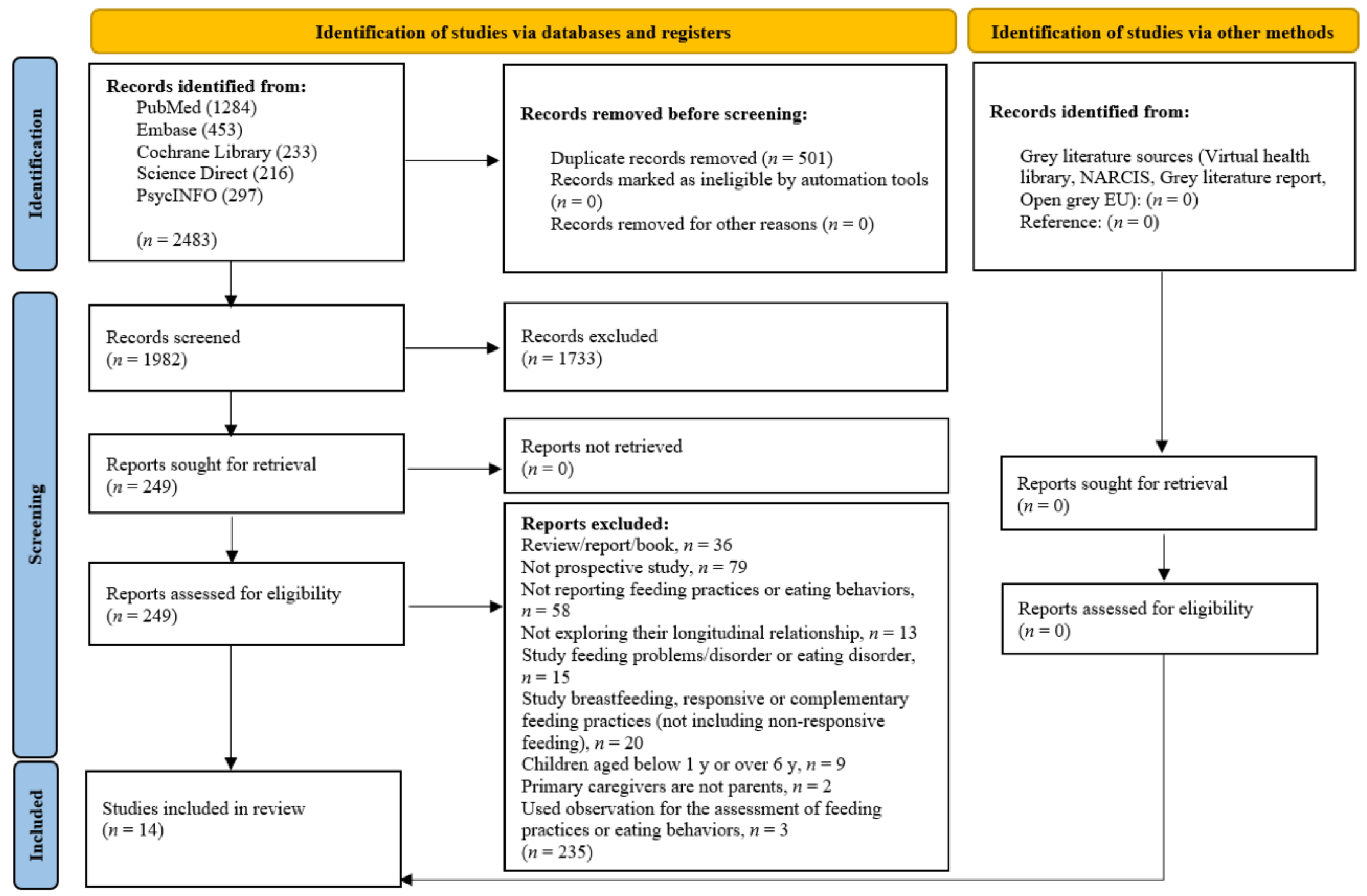
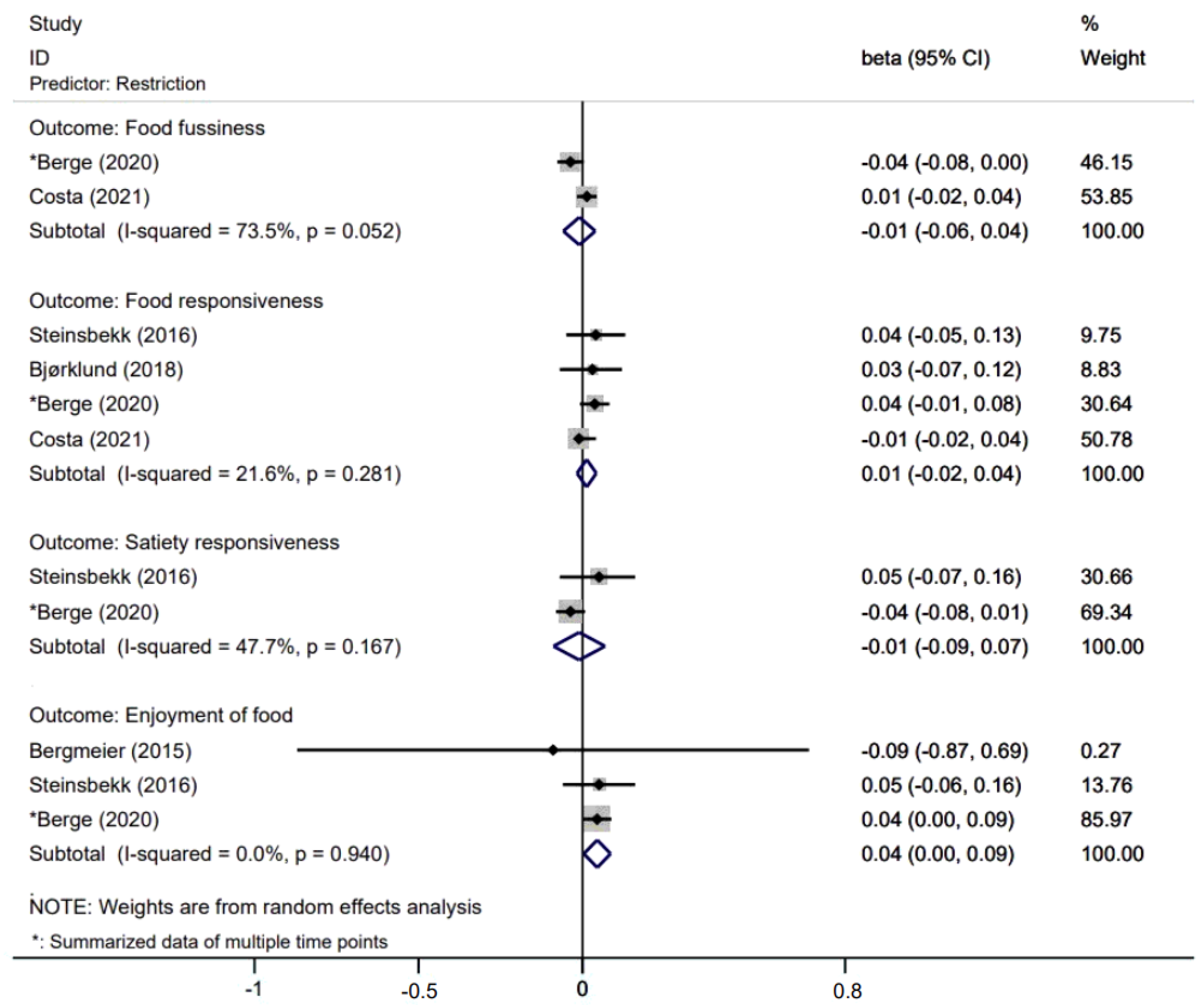
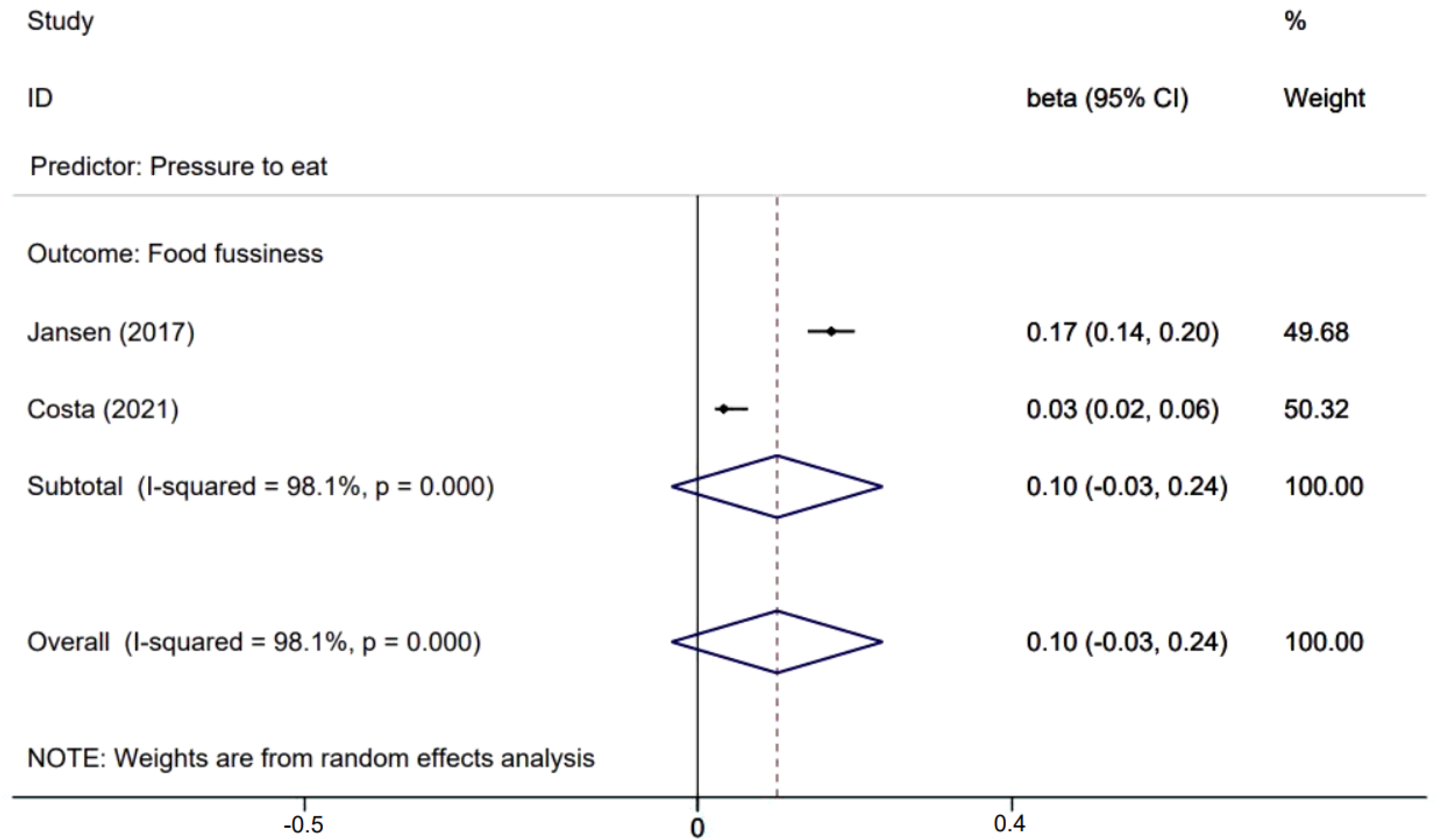
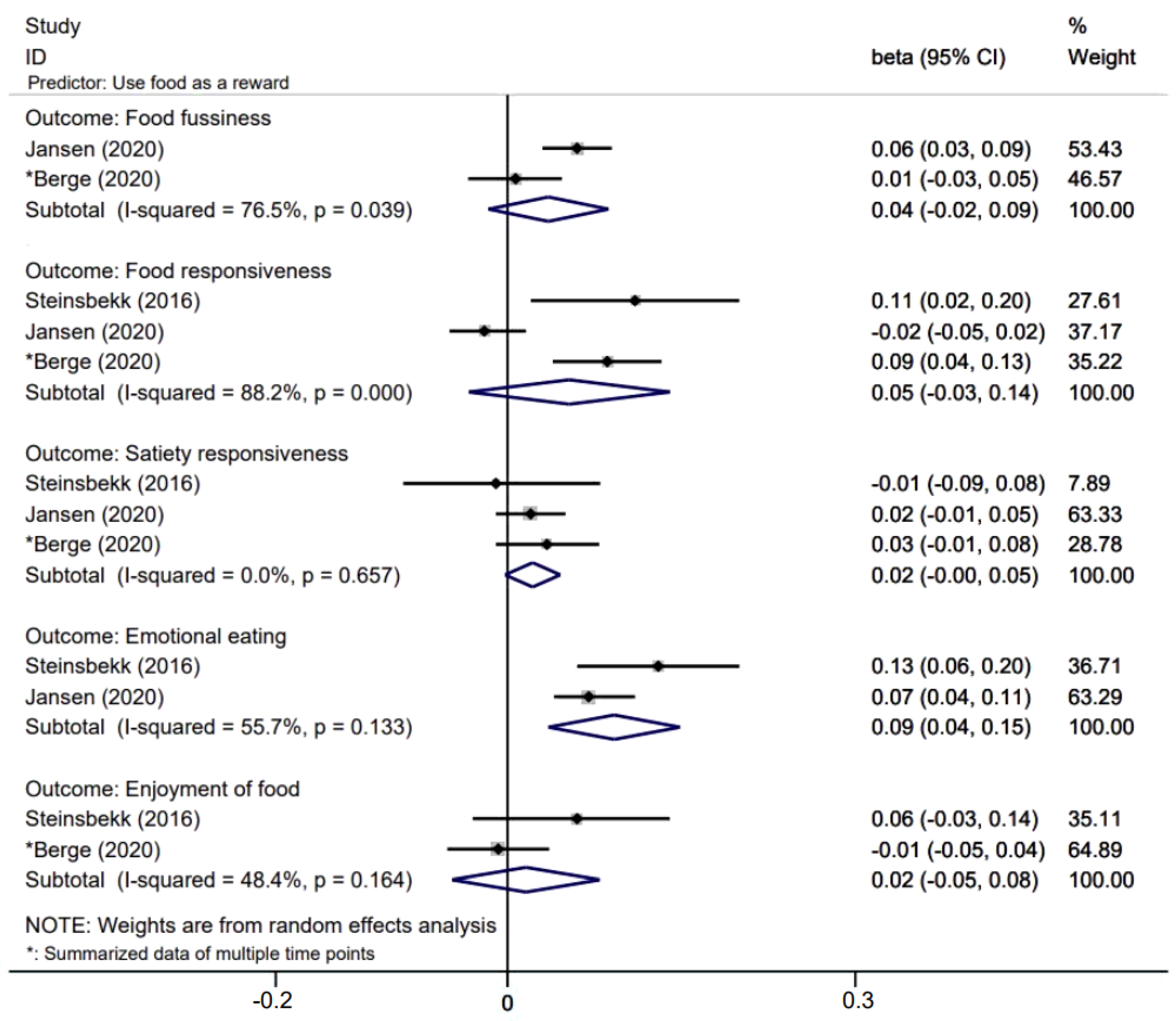
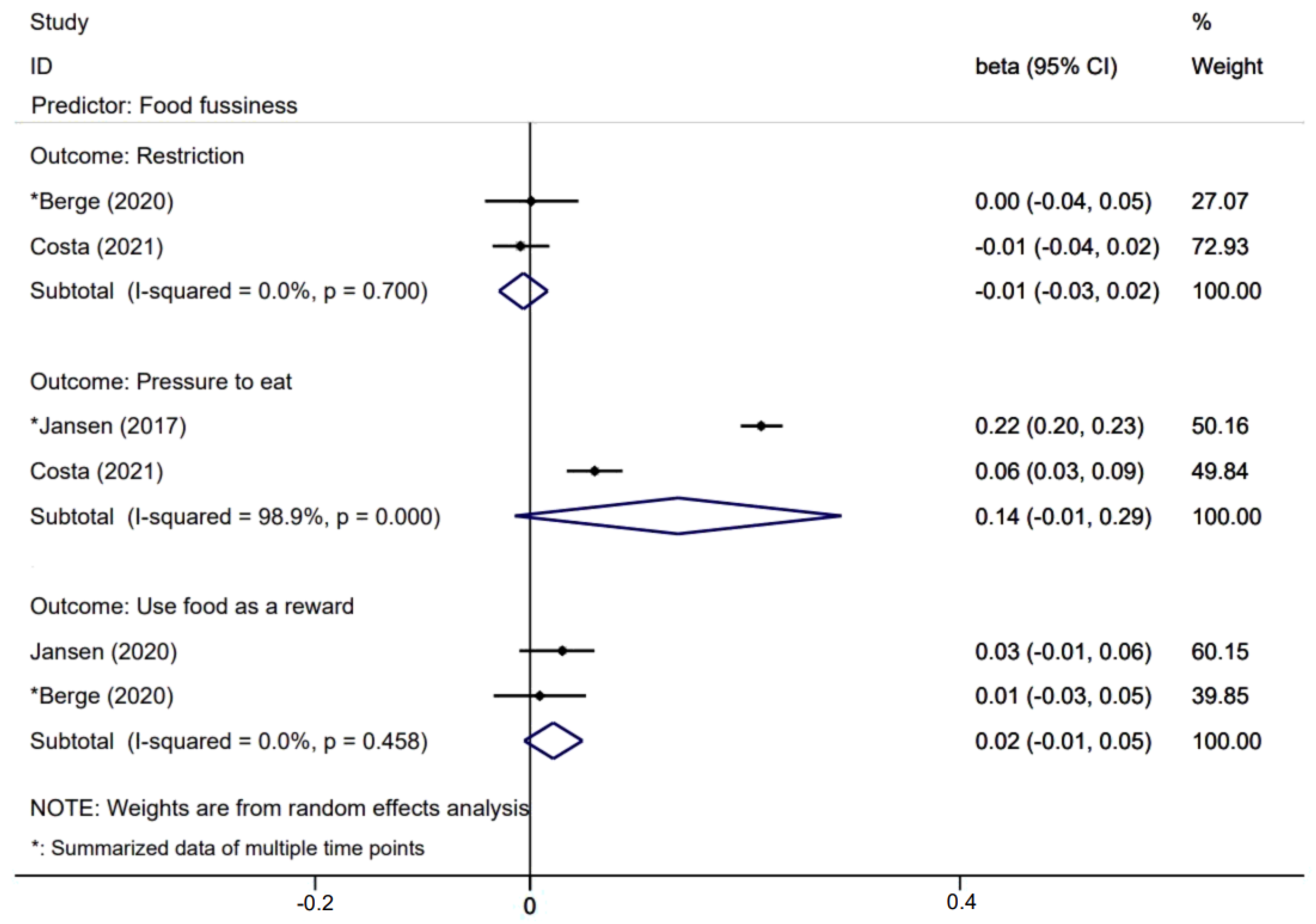
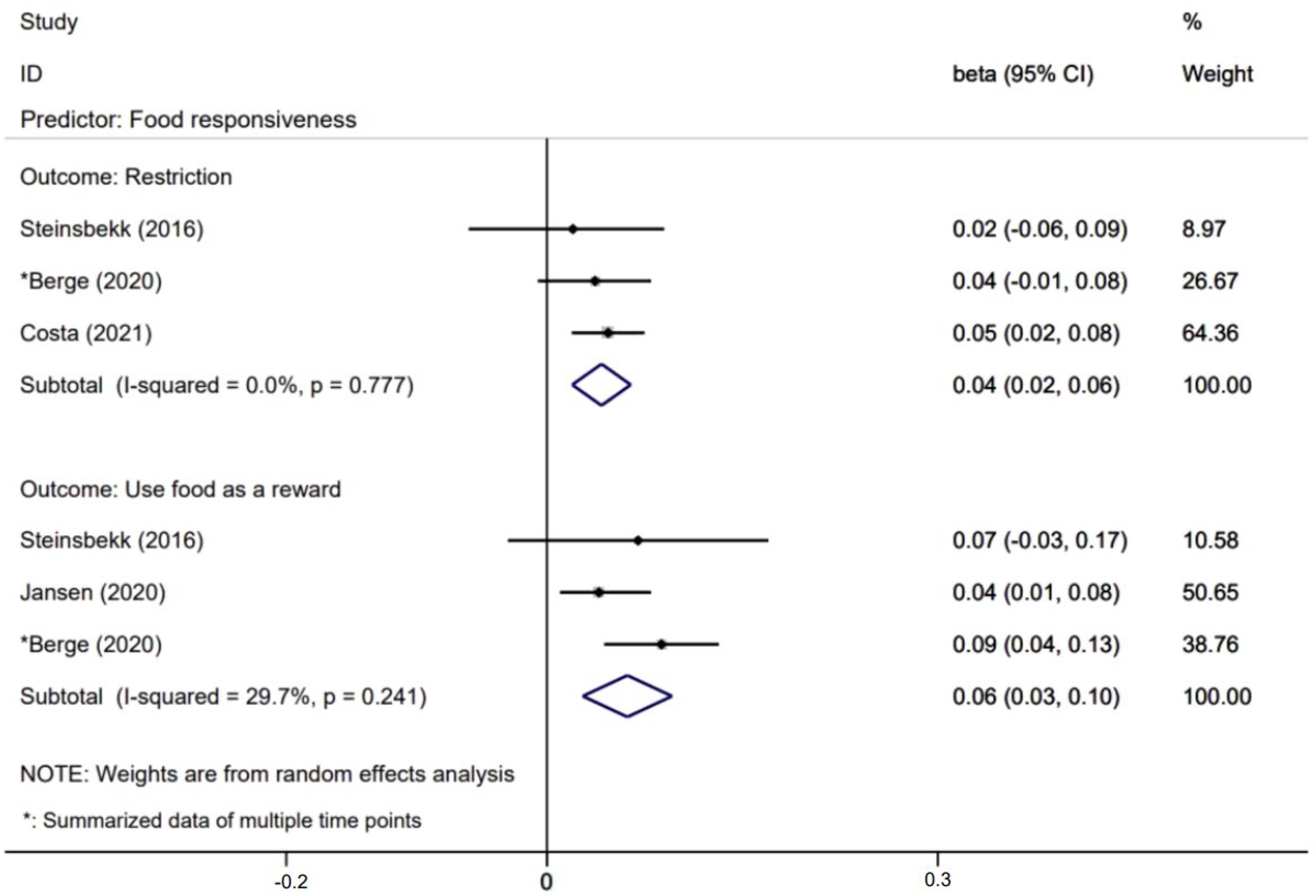
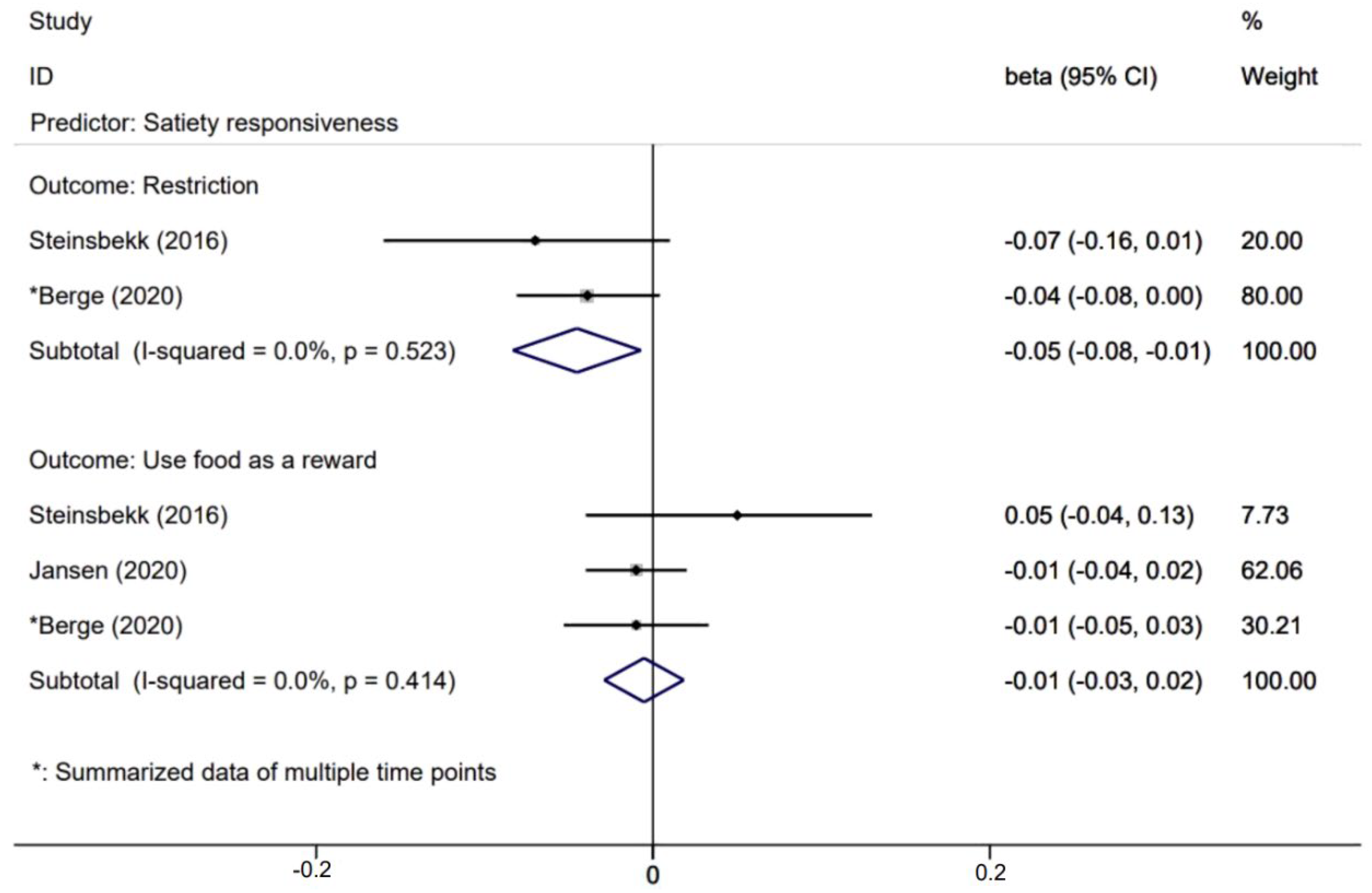

| First Author, Year | Country | Frequency and Duration of Follow-Up | Caregivers | Age of Children at Recruitment | Sampling Method | Sample Size | Response Rate |
|---|---|---|---|---|---|---|---|
| Jansen et al., 2018 [14] | Australia | Three time points One for 1.7 years and one for 1.3 years | Mothers | 2 years old. | Secondary data used a consecutive sample | 207 | 59.83% (207/346) |
| Jansen et al., 2017 [31] | Netherlands | Four times for assessing children’s eating One for 1.5 years, one for one year and one for three years | Mothers | 1.5 years old | Population-based sample | 4845 | 66.41% (4845/7295) |
| Lumeng et al., 2018 [34] | US | Three time points Each for 6 months | Mothers | 21 months old | Voluntary (response) sample | 222 | 90.98% (222/244) |
| Mallan et al., 2018 [66] | Australia | Three time points One for 1.7 years and one for 1.3 years | Mothers | 2 years old | Secondary data used a consecutive sample | 207 | 59.83% (207/346) |
| Steinsbekk et al., 2016 [32] | Norway | Two time points Two years | Parents | 6 years old | Voluntary (response) sample | 623 | 78.17 (623/797) |
| Rodgers et al., 2013 [30] | Australia | Two time points One year | Mothers | 1.5 years old | Voluntary (response) sample | 222 | 68.70% (222/323) |
| Bergmeier et al., 2015 [40] | Australia | Two time points One year | Mothers | 2 years old | Part of a longitudinal data which was 2-stage clustered sampling | 72 | 91.14% (72/79) |
| Gregory et al., 2010 [52] | Australia | Two time points One year | Mothers | 2 years old | Voluntary (response) sample | 156 | 85.25% (156/183) |
| Bjørklund et al., 2018 [64] | Norway | Three time points Each for two years | Parents | 6 years old | A representative community sample | 702 | 88.08% (702/797) |
| Bergmeier et al., 2014 [67] | Australian | Two time points One year | Mothers | 2 years old | Voluntary (response) sample | 201 | 100.00% (201/201) |
| Zohar et al., 2020 [62] | US | Three time points Each for one year | Mothers | 3.33 years old | Voluntary (response) sample | 215 | 100.00% (215/215) |
| Jansen et al., 2020 [53] | Netherlands | Two time points Five years | Parents | 4 years old | Population-based sample | 3642 | 80.17% (3642/4543) |
| Berge et al., 2020 [63] | US | Four time points Each for 12 months | Parents | 3.3 years old | Random sampling | 534 | 100% (534/534) |
| Costa et al., 2021 [65] | Portugal | Two time points Three years | Mothers | 4 years old | Population-based sample | 3500 | 94.65% (3500/3698) |
| First Author, Year | Measures and Variables Related to Non-Responsive Feeding | Measures and Variables Related to Eating Behaviors | Covariates in the Final Model |
|---|---|---|---|
| Jansen, et al., 2018 [14] | FPSQ
| CEBQ
| Child BMI z-score at 14 months |
| Jansen et al., 2017 [31] | CFQ Pressure to eat | CBCL/CEBQ Fussy eating | Maternal ethnicity, education, psychopathology score and BMI, child gender, and breastfeeding duration |
| Lumeng et al., 2018 [34] | IFSQ Pressure to eat | CEBQ-T/BAMBI Picky eating | Did not report the covariates |
| Mallan et al., 2018 [66] | FPSQ
| CEBQ Food Fussiness | Child gender and maternal education did not substantively change any of the models The models did not include any covariates in the final model |
| Steinsbekk et al., 2016 [32] | PFSQ
| CEBQ
| Child BMI, parental BMI, and family socioeconomic status (SES) at age 6 years |
| Rodgers et al., 2013 [30] |
| DEBQ-P Emotional eating | T1 feeding practice and eating behaviors |
| Bergmeier et al., 2015 [40] | CFQ
| CEBQ
| Maternal education, child BMI Z-score at T1, maternal control and concern about child weight, and child difficult temperament |
| Gregory et al., 2010 [52] | CFQ
| CEBQ
| Maternal age, BMI and education, and child age; gender; T1 eating behavior; and T1 feeding practices |
| Bjørklund et al., 2018 [64] |
| CEBQ Food responsiveness | Child and parent BMI |
| Bergmeier et al., 2014 [67] | CFQ
| CEBQ
| Maternal educational achievement, family income, and maternal BMI Child temperament, maternal Warmth and Control, and mother–child dysfunctional interaction T1 child eating behaviors and child BMI Z-score |
| Zohar et al., 2020 [62] | CFQ
| FILAD Picky eating | Birth order, child temperament, child executive function, and child sex |
| Jansen et al., 2020 [53] | CFQ Use food as a reward | CEBQ
Fussy eating | Child BMI, sex, and ethnicity Parental BMI |
| Berge et al., 2020 [63] | PFSQ
| CEBQ
| Child age, child sex, child BMI, child race, household maximum education attainment, household income, BMI of the primary adult respondent, and treatment group assignment. |
| Costa et al., 2021 [65] | CFQ
| CEBQ
| Child sex and BMI Z-score at 4 y of age and maternal education |
| Food Fussiness | Food Responsiveness | Satiety Responsiveness | Emotional Eating | Enjoyment of Food | Total | |
|---|---|---|---|---|---|---|
| Restriction | 0/7 (0/10) | 0/6 (0/9) | 0/3 (0/6) | 0/1 (0/1) | 1/5 (1−/7) | 1/10 (1−/33) |
| Pressure to eat | 2/7 (2+/10) | 1/2 (1+/2) | 0/0 (0/0) | 0/0 (0/0) | 2/3 (2−/3) | 4/7 (3+, 2−/15) |
| Use food as a reward | 2/3 (2+/8) | 3/5 (4+/10) | 0/4 (0/9) | 2/2 (2+/2) | 0/2 (0/4) | 5/6 (8+/33) |
| Emotional feeding | 0/1 (0/3) | 1/1 (2+/3) | 1/1 (1+, 1−/3) | 1/1 (1+/1) | 0/1 (0/3) | 2/2 (4+, 1−/13) |
| Total | 4/10 (4+/31) | 4/7 (7+/24) | 1/4 (1+, 1−/18) | 3/3 (3+/4) | 2/5 (3−/17) | 10/14 (15+, 4−/94) |
| Food Fussiness | Food Responsiveness | Satiety Responsiveness | Emotional Eating | Enjoyment of Food | Total | |
|---|---|---|---|---|---|---|
| Restriction | 0/3 (0/6) | 1/4 (1+/7) | 1/3 (1+/6) | 0/1 (0/1) | 0/2 (0/4) | 2/5 (2+/24) |
| Pressure to eat | 2/3 (3+/7) | 1/1 (1−/1) | 0/0 (0/0) | 0/0 (0/0) | 0/0 (0/0) | 2/3 (3+, 1−/8) |
| Use food as a reward | 1/3 (1+/8) | 2/4 (3+/9) | 1/4 (1−/9) | 1/2 (1+/2) | 1/2 (1+/4) | 3/6 (6+, 1-/32) |
| Emotional feeding | 1/1 (1−/3) | 0/1 (0/3) | 0/1 (0/3) | 1/1 (1+/1) | 0/1 (0/3) | 2/2 (1+, 1−/13) |
| Total | 4/6 (4+, 1−/24) | 3/5 (4+, 1−/20) | 2/4 (1+, 1−/18) | 2/3 (2+/4) | 1/2 (1+/11) | 7/9 (12+, 3−/77) |
Publisher’s Note: MDPI stays neutral with regard to jurisdictional claims in published maps and institutional affiliations. |
© 2022 by the authors. Licensee MDPI, Basel, Switzerland. This article is an open access article distributed under the terms and conditions of the Creative Commons Attribution (CC BY) license (https://creativecommons.org/licenses/by/4.0/).
Share and Cite
Wang, J.; Zhu, B.; Wu, R.; Chang, Y.-S.; Cao, Y.; Zhu, D. Bidirectional Associations between Parental Non-Responsive Feeding Practices and Child Eating Behaviors: A Systematic Review and Meta-Analysis of Longitudinal Prospective Studies. Nutrients 2022, 14, 1896. https://doi.org/10.3390/nu14091896
Wang J, Zhu B, Wu R, Chang Y-S, Cao Y, Zhu D. Bidirectional Associations between Parental Non-Responsive Feeding Practices and Child Eating Behaviors: A Systematic Review and Meta-Analysis of Longitudinal Prospective Studies. Nutrients. 2022; 14(9):1896. https://doi.org/10.3390/nu14091896
Chicago/Turabian StyleWang, Jian, Bingqian Zhu, Ruxing Wu, Yan-Shing Chang, Yang Cao, and Daqiao Zhu. 2022. "Bidirectional Associations between Parental Non-Responsive Feeding Practices and Child Eating Behaviors: A Systematic Review and Meta-Analysis of Longitudinal Prospective Studies" Nutrients 14, no. 9: 1896. https://doi.org/10.3390/nu14091896
APA StyleWang, J., Zhu, B., Wu, R., Chang, Y.-S., Cao, Y., & Zhu, D. (2022). Bidirectional Associations between Parental Non-Responsive Feeding Practices and Child Eating Behaviors: A Systematic Review and Meta-Analysis of Longitudinal Prospective Studies. Nutrients, 14(9), 1896. https://doi.org/10.3390/nu14091896






